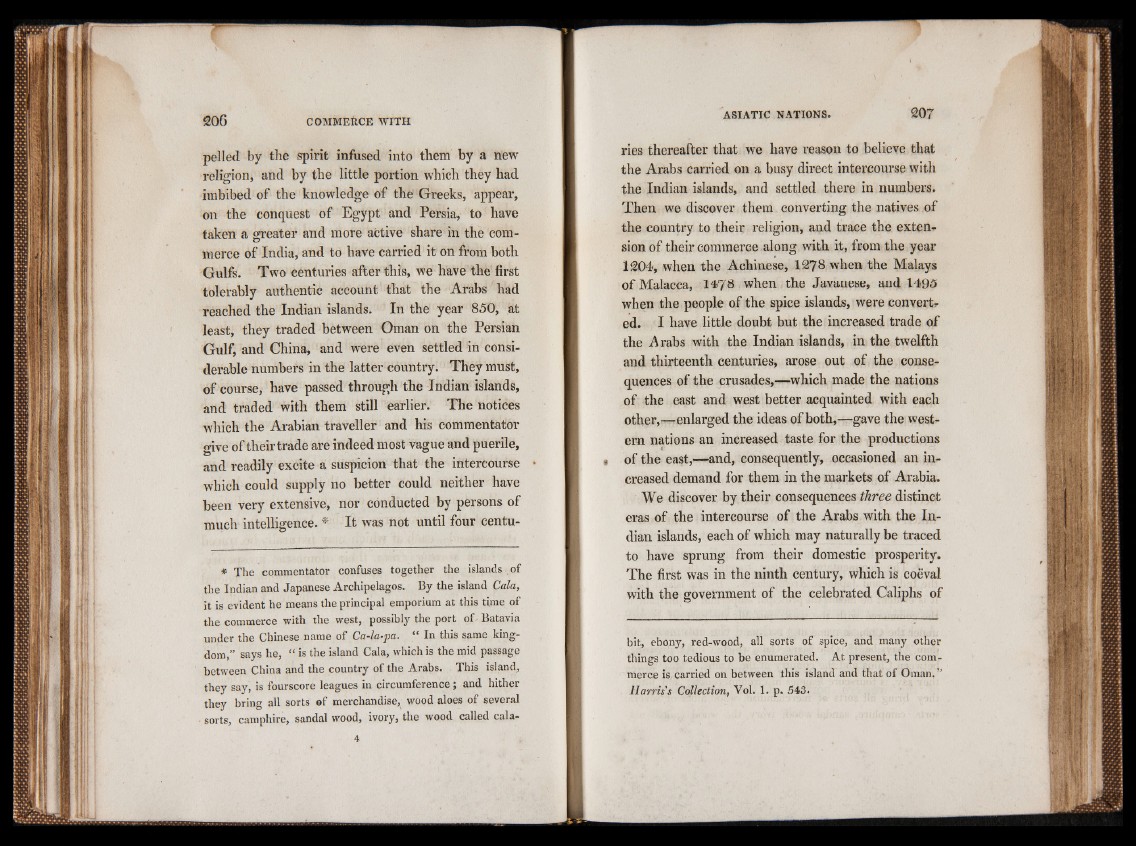
pelled by the spirit infused into them by a new
religion, and by the little portion which they had
imbibed of the knowledge of the Greeks, appear,
on the conquest of Egypt and Persia, to have
taken a greater and more active share in the commerce
of India, and to have carried it on from both
Gulfs. Two centuries after this, we have the first
tolerably authentic account that the Arabs had
reached the Indian islands. In the year 850, at
least, they traded between Oman on the Persian
Gulf, and China, and were even settled in considerable
numbers in the latter country. They must,
of course, have passed through the Indian islands,
and traded with them still earlier. The notices
which the Arabian traveller and his commentator
give of their trade are indeed most vague and puerile,
and readily excite a suspicion that the intercourse
which could supply no better could neither have
been very extensive, nor conducted by persons of
much intelligence. * It was not until four centu*
The commentator confuses together the islands of
the Indian and Japanese Archipelagos. By the island Cala,
it is evident he means the principal emporium at this time of
the commerce with the west, possibly the port of- Batavia
under the Chinese name of Ca-la-pa. “ In this same kingdom,”
says he, “ is the island Cala, which is the mid passage
between China and the country of the Arabs. This island,
they say, is fourscore leagues in circumference; and hither
they bring all sorts of merchandise, wood aloes of several
sorts, camphire, sandal wood, ivory, the wood called calaries
thereafter that we have reason to believe that
the Arabs carried on a busy direct intercourse with
the Indian islands, and settled there in numbers.
Then we discover them converting the natives of
the country to their religion, and trace the extension
of their commerce along with it, from the year
1204, when the Achinese, 1278 when the Malays
of Malacca, 1478 when the Javanese, and 1495
when the people of the spice islands, were convert*-
ed. I have little doubt but the increased trade of
the Arabs with the Indian islands, in the twelfth
and thirteenth centuries, arose out of the consequences
of the crusades,—which made the nations
of the east and west better acquainted with each
other,-—enlarged the ideas of both,—gave the western
nations an increased taste for the productions
of the east,—and, consequently, occasioned an increased
demand for them in the markets of Arabia.
We discover by their consequences three distinct
eras of the intercourse of the Arabs with the Indian
islands, each of which may naturally be traced
to have sprung from their domestic prosperity.
The first was in the ninth century, which is coeval
with the government of the celebrated Caliphs of
bit, ebony, red-wood, all sorts of spice, and many other
things too tedious to be enumerated. At present, the commerce
is carried on between this island and that of Oman.*’
Harris's Collection, Vol. f. p. 543.